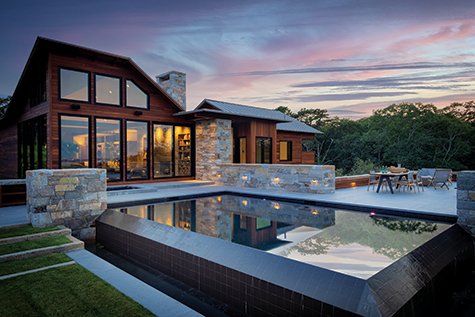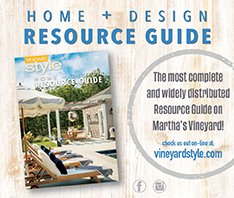HOME PORTRAIT

Crafting Dreams not Simply Homes
The Visionary Work of R+D Studio
By Diane Alter, Photography by Michael J. Lee
Meet Travis Richie, principal of the Island’s R+D Studio. Each project Travis undertakes is a canvas upon which he paints his love for both the tangible and the intangible, merging form and function in a harmonious yet sleek dance that echoes the natural beauty of the Island. Via the salty ocean breezes that whisper through the streets, Travis finds inspiration in the rugged cliffs, the quaint cottages, and the rich tapestry of stories embedded in every brick and beam, guiding his hands to create structures that not only stand the test of time but also tell tales of passion, creativity, and the enduring appeal of Martha’s Vineyard.
That attraction captured Travis as a young child. A Virginia native, he spent his summers on the Island and returned often during his college and later years. After receiving a Master of Architecture from the University of Texas in Austin, and finding the hot, hot, hot Lone Star state summers difficult to endure, Travis moved to Martha’s Vineyard in 2015 with his wife Erin–an interior designer who often works with him. “I won’t say it was an easy decision, but we were both ready for a change,” Travis said.
“The Island’s charm and desire for change that brings many people to the Island,” Travis explains. “It’s the beauty of the place and the laidback environment that attracts and keeps people here. It’s a beautiful Island. It’s a beautiful place to be.”
Quality and detail are paramount in each of Travis’ designs. Extensive research and consulting with engineers and builders early in the process is crucial. Each structure has a clear intent encompassing not just the home but the landscape and interior design.
Before picking up a drafting pen, Travis spends a great deal of time speaking with clients to make sure he captures the vision they have in mind and stays honest with the site. His designs blend in with their surroundings. Still, they are hard to overlook thanks to their unfussy features and large glass panels. Outdoor settings are framed around the surrounding site with a “no-maintenance approach.” The cedar, stone, and glass effectively hold up against the Island’s weather, aging naturally ˆand beautifully.
Projects in the downtown historic areas of the Island significantly differ from a 10-acre parcel of land in the woods where no one is around and Island creatures are known to roam.
“One commonality, wherever the home is built, is the Island’s tried and true culture of spending time with family and friends, Travis explained. With that in mind, creating beautiful exterior social spaces, which are easily transformed into rooms, is important. Screens on porches can be switched out for glass panels and fireplaces can be used for natural heat.
The location’s environment informs a lot of Travis’s decisions from the exterior to the interior. It plays a big part in things such as cross-ventilation. Central air, once rare inside Island homes, is a common request. Passive strategies, meanwhile, mean good natural air circulation and natural light. Homes are built so that every room, even the laundry room, stays light during daylight hours without the switch of an electric light. Humidity in Martha’s Vineyard is a perpetual challenge, Travis explained. “Summers are hot and humid. Winters are cold and humid.
Humidity is one thing you can count on during every season. And sadly rain, which sometimes falls horizontally. With that in mind, we design deep overhangs on doorways to help guard against getting soaked going to and from the house.”
Designing homes and their exteriors on MV requires careful consideration to combat moisture’s effects on structural integrity and aesthetics, Travis continued. High humidity levels can lead to issues such as mold growth, wood rot, and paint peeling, compromising the durability and appearance of buildings over time.
When temperatures soar, the combination of heat and humidity can create discomfort indoors, making proper ventilation and insulation crucial for maintaining a comfortable living environment. Additionally, exterior materials must be selected and treated to withstand the corrosive effects of moisture and salt spray from the nearby ocean. During colder months, humidity can exacerbate issues such as condensation and moisture buildup, leading to potential damage to building materials and interior finishes.
Proper insulation and moisture barriers are essential to prevent these problems and ensure energy efficiency. In essence, architect home designs in Martha’s Vineyard must employ strategies to mitigate the challenges posed by the Island’s humid climate, incorporating materials, techniques, and systems that prioritize durability, comfort, and resilience against moisture-related issues.
Another challenge in Martha’s Vineyard is navigating zoning and permits, especially when historic properties are involved and environmental considerations arise. Both require intricate design due to the island’s rich history and sensitive ecosystem.
“We spend a lot of time understanding all of the different sorts of forces and factors from cultural, to natural to social,” Travis said. “We have a tremendous amount of respect for historic sites and try to integrate at least some of their storied pasts into the present.”
Martha’s Vineyard boasts a treasure trove of historic properties, each with unique charm and significance. Zoning regulations often aim to preserve the architectural integrity and cultural heritage of these buildings, imposing restrictions on alterations, demolitions, and new constructions within designated historic districts. Obtaining permits for modifications or additions to historic properties requires compliance with strict guidelines and approval from historic preservation boards or commissions. As a coastal region, Martha’s Vineyard is subject to stringent environmental regulations to protect its fragile ecosystems, including wetlands, dunes, and coastal habitats. Development projects must undergo thorough environmental impact assessments to assess potential impacts on wildlife, water quality, and natural resources. Permits may be required for shoreline stabilization, dredging, or construction in environmentally sensitive areas, with oversight from agencies such as the Massachusetts Department of Environmental Protection and local conservation commissions.
Zoning regulations on Martha’s Vineyard often include provisions limiting the height and density of buildings to preservescenic vistas, maintain neighborhood character, and prevent overcrowding. Developers can encounter challenges when proposing projects that exceed these limitations, requiring variances or special permits from zoning boards or various Island planning commissions.
Given the Island’s limited freshwater resources and susceptibility to pollution, regulations governing septic systems are stringent. Development projects must comply with requirements for wastewater management, including soil testing, setback distances from water bodies, and installation of advanced treatment systems to minimize nutrient runoff and groundwater contamination.
Development along Martha’s Vineyard’s coastline is subject to regulations aimed at protecting against erosion, flooding, and storm surge. Permits may be required for shoreline protection measures, such as seawalls or revetments, with consideration given to potential impacts on coastal dynamics and public access to beaches.
Navigating these zoning and permit challenges requires careful planning and consultation with relevant authorities. Enlisting a professional firm like R+D studio, who knows the nuances, is imperative.
Any challenges are quickly forgotten when a dream home is completed and a new chapter of life on the Island begins.
When at home with his wife and two young boys, Travis is a busy husband and father. And when time permits, he finds solace in the tranquility of sailing with the gentle embrace of the ocean and the whisper of the wind offering moments of clarity.
Out to sea, one can imagine Travis taking inspiration from his surroundings and mentally crafting visionary spaces that transcend the ordinary. For him, Martha’s Vineyard is more than just a place–it’s a canvas upon which his life’s journey unfolds, a testament to his unwavering passion for both the art of architecture and the art of living well.
And that is the gift Travis shares with others–as well as the Island.
To find out more about R+D Studio: rdstudiomv.com, rdstudiomv@gmail.com, 508-338-2292








